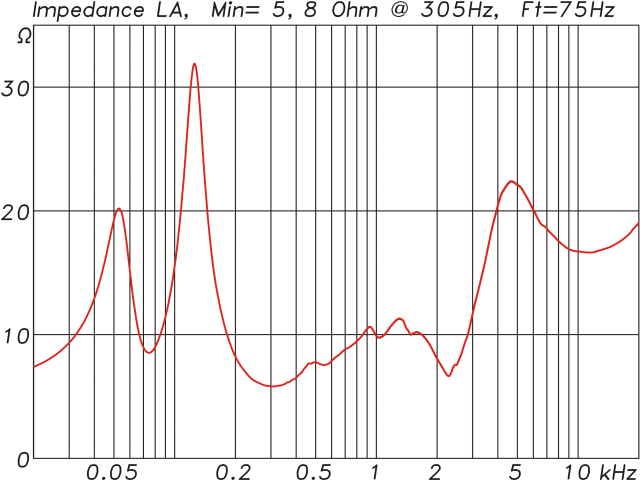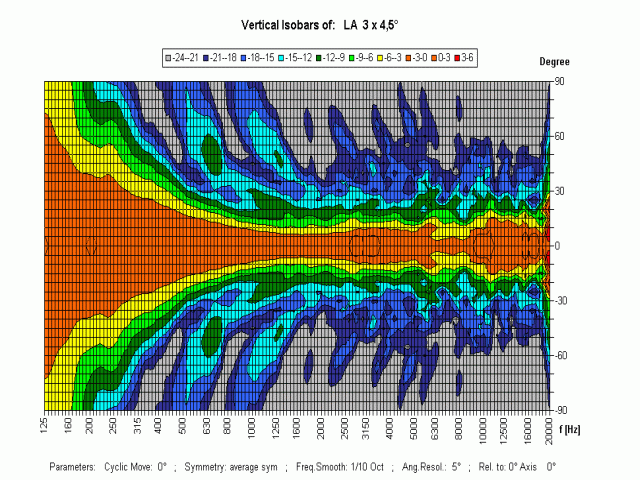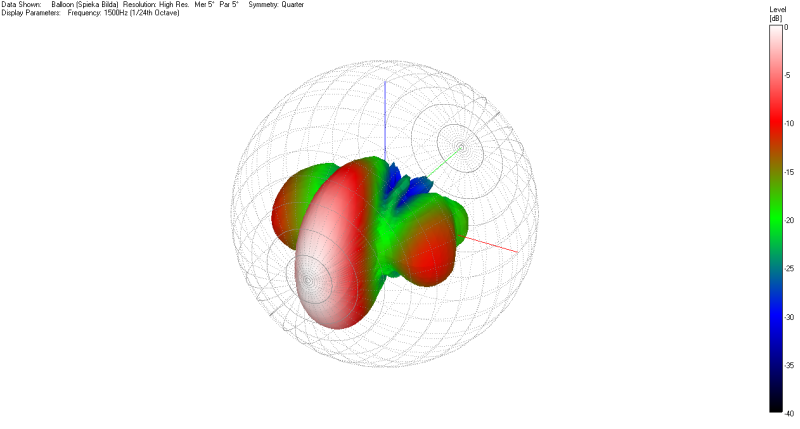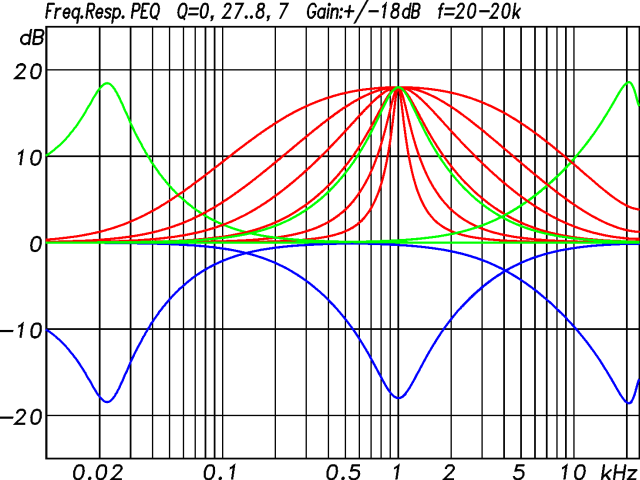Measurement
The evaluation of electroacoustic systems and their elements is possible only through objective measurements. These are also the basis on which data sheets are put together. Components like loudspeakers and amplifiers can be tested in the ideal conditions of a laboratory, whereas extensive installations are checked and optimized on-site.
Loudspeaker Measurement
Our loudspeaker measurements are performed using the approved measuring system and WinMF in our own class1 semi-anechoic chamber, which allows measuring distances up to 8m. For the acoustic measurements Class 1 microphones and amplifiers by Brüel & Kjaer are used, as well as a Robo3 front end, which make possible sampling rates up to 96kHz at a resolution of 24Bit.
For measuring directivity and balloon data a rotatable arm (ELF-System) is available, which allows measurements on loudspeakers weighing up to 100kg with a maximum diagonal dimension of 150cm. Maximum SPL is measured with a Crown IT 12000HD amplifier providing 4500W per channel at 4 Ohm.
Specification
In order to make a choice of adequate loudspeakers for their specific demands, audio technicians, project engineers or architects need data sheets, which conveniently describe all the relevant information about the product. Acoustic and electric characteristics in particular are key criteria. State-of-the-art measurements performed on a loudspeaker in adequate measuring conditions provide the basis for these data sheets.
The measurements are carried out in a semi-anechoic chamber in quasi free field conditions with the microphone positioned on the solid floor in the far field (depending on the size of the loudspeaker at a distance of 2 to 8m)
Passive Loudspeakers
The sensitivity, being the major characteristic, is determined and normalized to 1W input power and a distance of 1m. Below the frequency limit of the anechoic chamber (approx. 100Hz), the curve is joined to an appendix from near field measurements of the membrane and the reflex port. In addition to the magnitude of the sensitivity, the phase is displayed.
The maximum sound pressure level plots the highest possible SPL against the frequency, with a given maximum power and a maximum fraction of non-linear distortion. The measurement is performed with sinusoidal signals, gradually raising the voltage, while SPL and percentage of distortion are being evaluated.
One important and often underestimated characteristic is the directivity. Single parameters like “60° horizontal” only give a vague information about the spatial pattern of the sound emission. The directivity should rather be displayed against the frequency, both horizontally and vertically. To accomplish this, measurements are made with the rotatable arm (ELF-System) or, in case of very large speakers, clusters and sets of line array elements, on a rotating plate.
| Standardmessungen | |
|---|---|
| Sensitivity | Magnitude, phase, average sensitivity |
| Impedance | Magnitude, phase, minimum, if applicable: tuning frequency |
| Maximum SPL | at 3% and 10% THD, calculated maximum SPL from sensitivity |
| Directivity | horizontally and vertically |
Additionally the following measurements can be included in the data sheet:
- Sensitivity, impedance and directivity of the individual channels
- Frequency response of the passive crossover network
- THD(f) (Total Harmonic Distortion) at multiple input voltages
- Power compression
Active Loudspeakers
The basic procedure of measuring sensitivity, maximum SPL and directivity is the same as for passive loudspeakers, whereas measurement of impedance is inapplicable. Additionally any possible parameters can be determined for the individual channels, active and/or passive, as well as frequency responses of the filters of an internal or external controller.
| Standardmessungen | |
|---|---|
| Sensitivity | Magnitude, phase, average sensitivity |
| Freq. resp. of filters | Room EQ, other filters |
| Maximum SPL | at 3% and 10% THD |
| Directivity | horizontally and vertically |
Additionally the following measurements can be included in the data sheet:
- Sensitivity, impedance and directivity of the individual channels
- Frequency responses of the active crossover filters and equalizers
- THD(f) (Total Harmonic Distortion) at multiple input voltages
- Limiter operation
Cluster/Line Arrays
Basically for line arrays the same measurements are made as for conventional loudspeakers. Furthermore measurements of the vertical directivity of complete arrays in several angular configurations can be useful, which give information about the characteristics in the far field. For the measurements on small array elements the rotatable arm (ELF-System) can be used, large arrays are measured on the rotating plate, which can precisely turn very heavy assemblies.
Simulation Data
Acoustic simulation software allows the prediction of room acoustic parameters like distribution of direct SPL, reverberation time and speech intelligibility, and even auralization, already during the planning period of a building or a sound system installation. For that purpose the impulse response of a room is determined using methods like mirror image sources and/or ray tracing. The precise simulation of sound systems depends on data sets containing the spatial radiation patterns. Basis for these data sets are spherical measurements of the loudspeaker in an appropriate angular resolution.
Using a rotatable arm (ELF-System), these measurements can be performed fully automated. The results are converted to the current data formats for EASE, Ulysses, CLF (CATT-Acoustic, LARA, Odeon, Ramsete) or assembled to a EASE Speaker Lab GLL. Ceiling speakers can be built into the boundary surface of the measuring chamber, and that way be evaluated in half space conditions. For conventional speaker systems an angular resolution of 5° is advisable, line arrays, having a strong directionality, demand a resolution of 2°.
Currently the most common format for displaying spatial characteristics is the Ease GLL. Beside the analysis of the entire speaker, the individual channels can be measured separately and, comprising the active or passive crossover network and filter functions, be put together in the GLL. In case of changes in the crossover network or the filters, the corresponding functions in the GLL can easily be replaced, without the need to measure the entire speaker again. Also different speaker models can be integrated in one GLL, and that way be made available to the client in compact shape. The Ease GLL can be opened with the free EASE GLL Viewer.
n order to attach the loudspeaker to the rotatable arm, it has to be furnished with the corresponding connector. This device consists of a 15mm-20mm multiplex plywood (min. 20cm x 20cm) with four M8 T-nuts sunk-in in the corners of a 14cm square. The board has to be mounted parallel to the front and axially behind the geometric center of the cabinet, around which the speaker is being rotated.

If the mounting hides the electrical connectors of the box, they have to be extended sideways. A cut-out in the 20cm square will not work, as it will be hidden by the link of the machine. For very heavy loudspeakers larger plywood boards can be used. Conventional mounting brackets are usually unsuitable for the rotary motion.
For slim column speakers, where the diffraction of the mounting plate has a significant influence, a smaller mounting plate can be used alternatively. It can be extended to the top and/or bottom if necessary.

Amplifier Measurement
Just as for loudspeakers, the choice of appropriate amplifiers for intended purposes requires substantial data specification. The compilation of these data sheets is based on parameters being determined by means of measurement. For measuring electronics a Rhode & Schwarz UPD is used. Beside the linear transfer characteristics, also harmonic, transient, intermodulation and difference tone distortion is recorded. Ultimately the power output of the amplifier is analyzed using signals with varying crest factors.
The evaluation of audio amplifiers covers the following measurements:
- Amplifier gain
- Frequency response (magnitude and phase) incl. cut-off frequencies (-3dB)
- Crosstalk attenuation (CTC)
- Common-Mode Rejection Ratio (CMRR)
- Damping factor
- Noise spectrum (unweighted/weighted)
- Maximum output voltage
- Total dynamic (unweighted/weighted)
- Total harmonic distortion (THD) against input voltage and THD(f)
- Distortion spectrum at 1kHz
- Transient intermodulation distortion (DIM100)
- Modulation distortion according to SMPTE (60Hz/7kHz)
- Difference frequency distortion (DFD according to IEC268)
- Power diagram (varying load impedance, continuous power, crest factors 6dB to 18dB, peak power)
Mixing Desks
Beside issues like features and ergonomics, the technical characteristics of a mixing desk are the main attributes, which decide on the qualification for a specific purpose.
Measurements can comprise:
- Amplifier gain
- Frequency response (magnitude and phase) incl. cut-off frequencies (-3dB)
- Crosstalk attenuation (CTC)
- Common-Mode Rejection Ratio (CMRR)
- Noise spectrum (unweighted/weighted)
- Maximum output voltage
- Total dynamic (unweighted/weighted)
- Total harmonic distortion (THD) against input voltage and THD(f)
- Distortion spectrum at 1kHz
- Transient intermodulation distortion (DIM100)
- Filter functions (high pass, low pass, bell and shelving filter, notch filter, etc.)


























